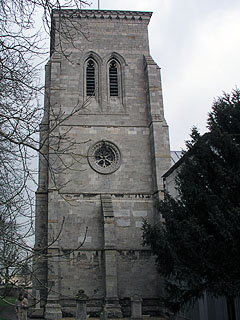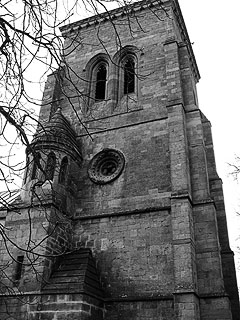Holy Trinity looks almost entirely Victorian from the outside: it is large, and dramatic, and has some deeply peculiar features (as I will shortly describe). However, what looks like a rebuild is actually just a very drastic restoration, and Pevsner tells me that there are some very interesting bits and bobs from the 13th and 14th centuries inside. Since we couldn't get in when we visited, I'm not in a position to talk about those yet, so what follows concerns just the outside.
In fact, it concerns just the tower, which was the only bit that I could think of anything to say about. This was rebuilt by Rowe in the big 1876 restoration, and is simultaneously weird and fascinating.
Weird, because he made no attempt to produce something that looked original or authentic: the west face has a doorway surrounded by engaged granite shafts (granite? in the Isle of Ely?), the new stair turret has a pepperpot roof and slit windows like something by Viollet-le-Duc, and the whole ensemble is topped by a ridiculous cap. I discovered subsequently that the tower was supposed to be topped off by a spire - the local legend is that it was never finished because the funds were stolen by a parishioner who fled to America, or so says the local legend - as conveyed by a nice man called Andy, who has e-mailed us several times to add interesting local colour to our knowledge. Andy also mentioned that the bells here are odd: apparently the bellmaker ran out of bronze while casting them, and finished the bells off by adding pewter plates stolen from the local pubs.
After the initial amusement caused by these, though, I looked a bit closer, and saw something odd. On each face, in the third stage, is a large round opening, filled with Victorian tracery. So far, nothing incongruous - if we have a Loire turret for the staircase, why not three rose windows to light the ringing chamber?
However, the rims of the openings are decorated with two concentric rings of bell-flowers, and I'm prepared to eat my hat if they aren't medieval: there's even a ring that's been restored on the north side to provide a helpful comparison.
There are similarly aged bell-flowers decorating the west window, along with some dog-tooth carving. Pevsner seems to think that these were just Rowe's attempt to recreate interesting stylistic details that had existed in the old tower (though he says 'it recalls what must have been interesting work of its date', which might indicate that he was a bit uncertain himself), but it looked to me more like they had reused medieval stonework. It all bodes well for the interior, anyway - watch this space…
Holy Trinity is locked, but there is keyholder information


